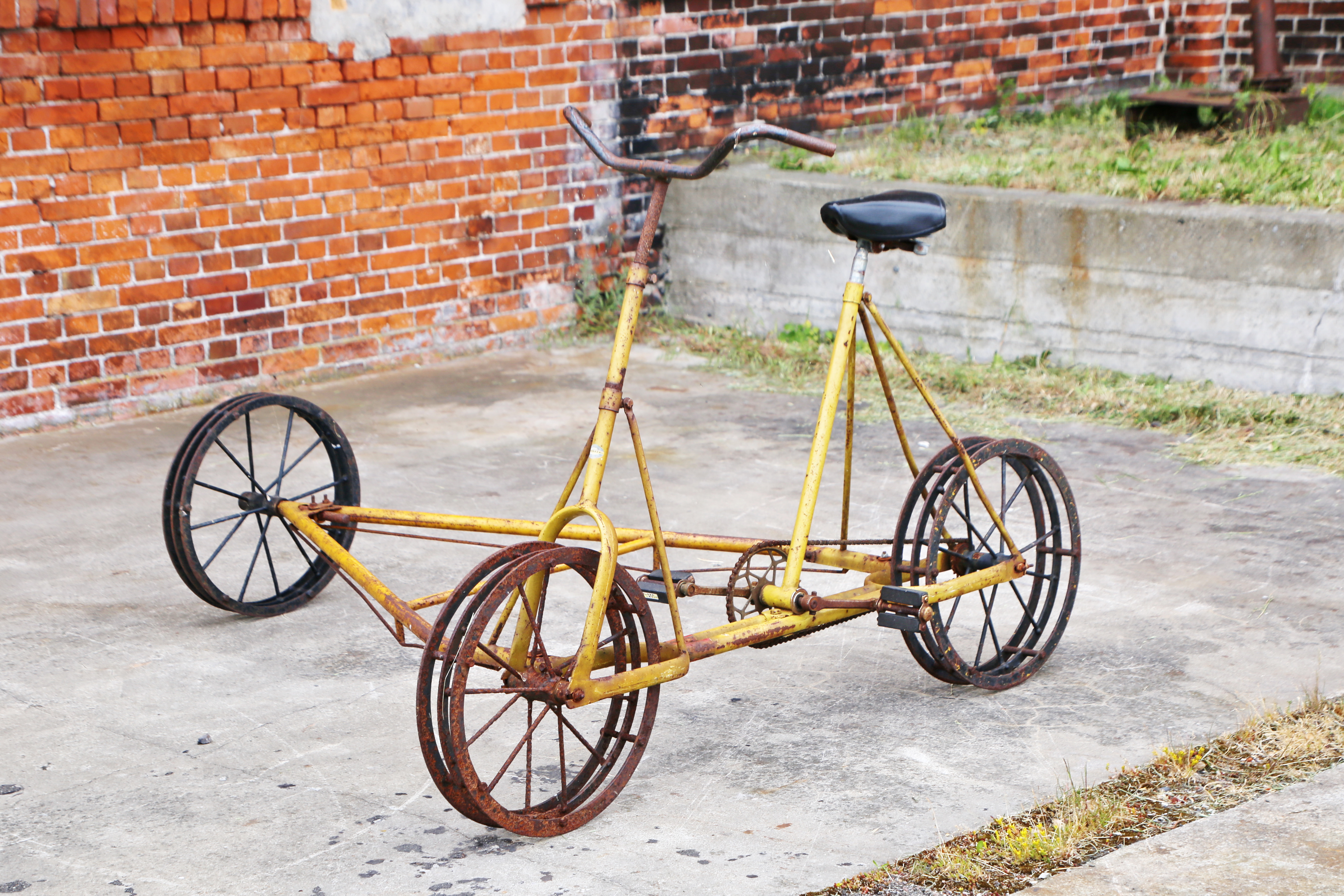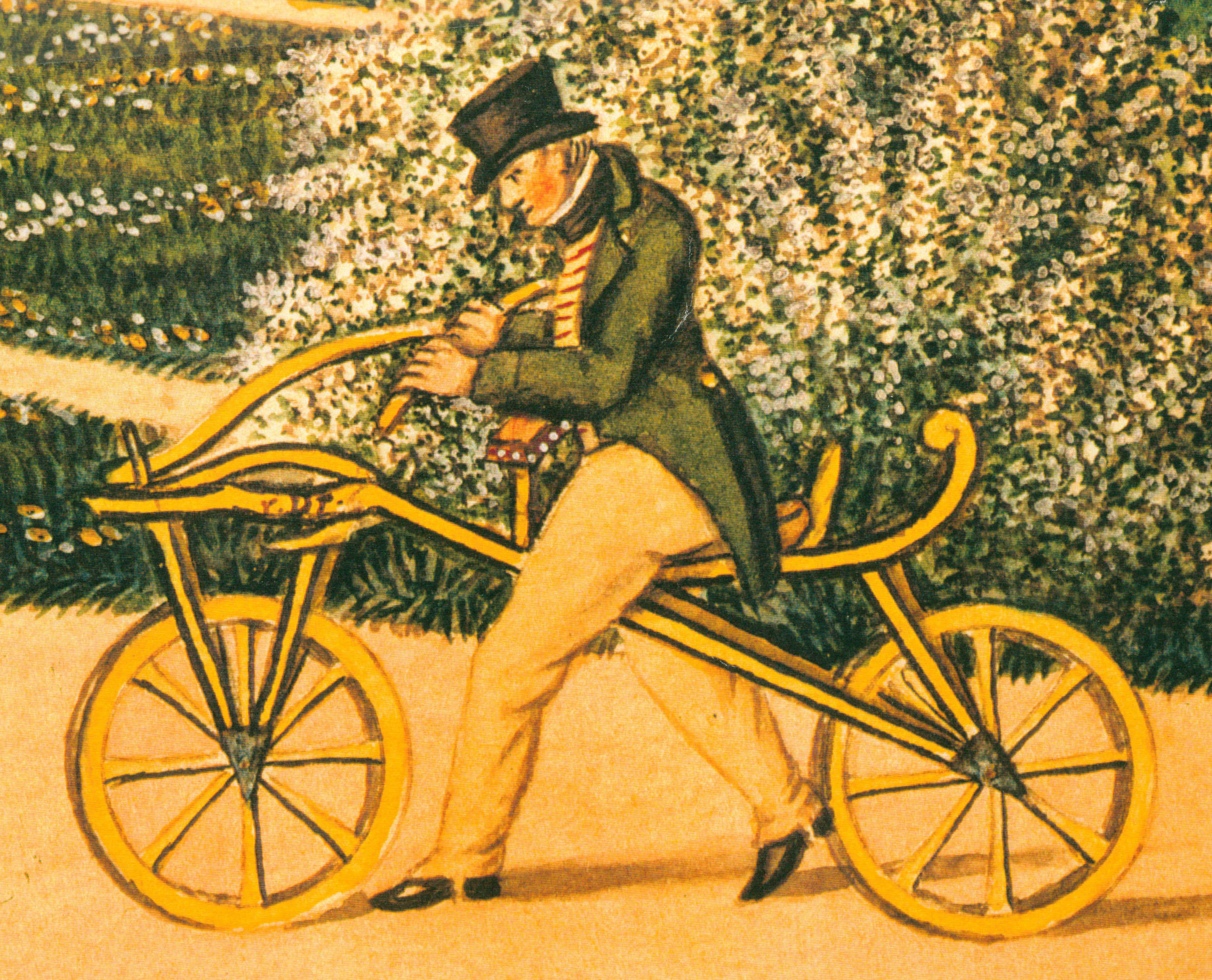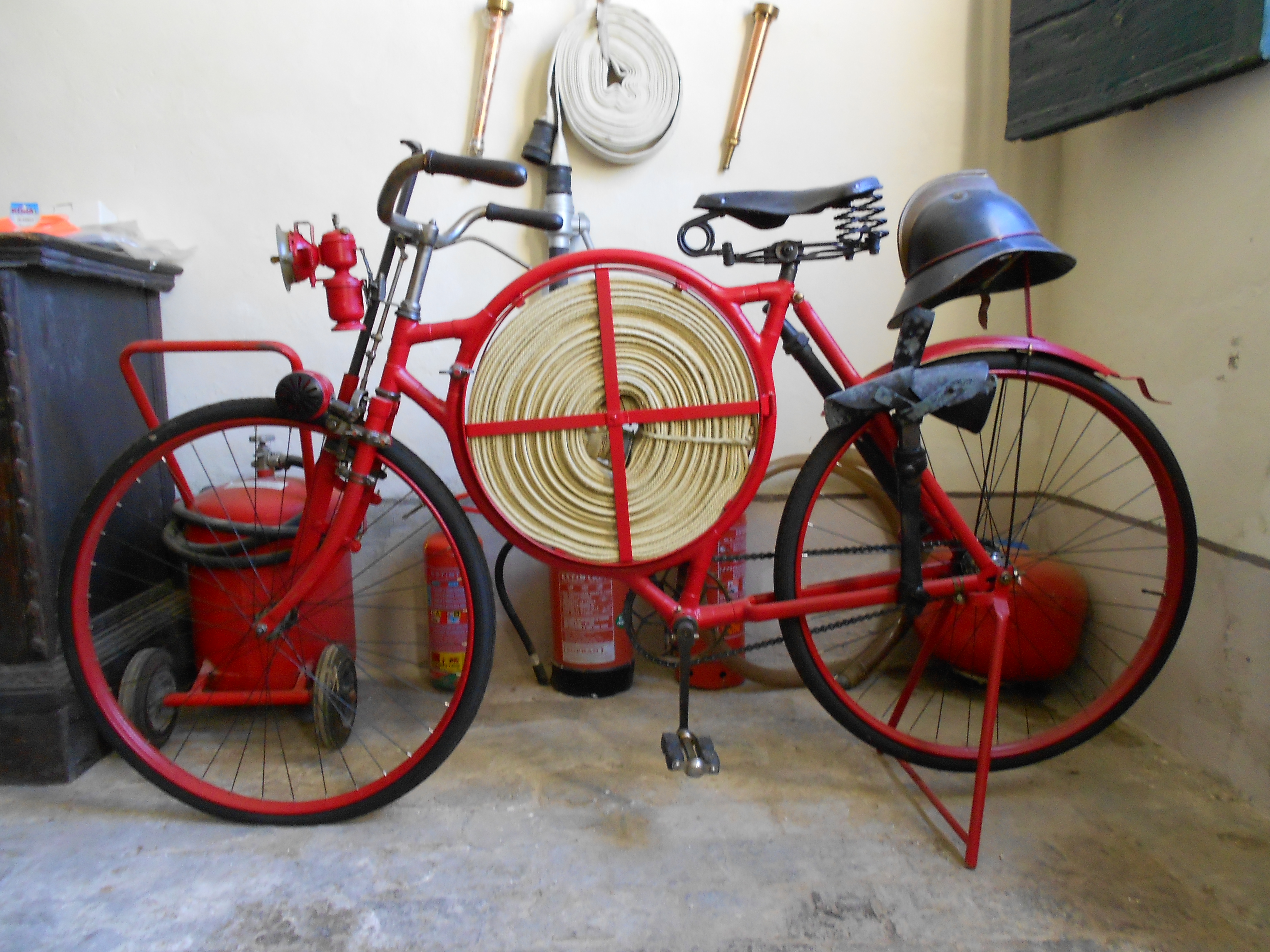|
Draisine
A draisine () is a light auxiliary rail vehicle, driven by service personnel, equipped to transport crew and material necessary for the maintenance of railway infrastructure. The eponymous term is derived from the German inventor Baron Karl Drais, who invented his '' Laufmaschine'' ( German for "running machine") in 1817, which was called ''Draisine'' in German (''vélocipède'' or ''draisienne'' in French) by the press. It is the first reliable claim for a practically used precursor to the bicycle, basically the first commercially successful two-wheeled, steerable, human-propelled machine, nicknamed hobby-horse or dandy horse. Later, the name draisine came to be applied only to the invention used on rails and was extended to similar vehicles, even when not human-powered. Because of their low weight and small size, they can be put on and taken off the rails at any place, allowing trains to pass. In the United States, motor-powered draisines are known as speeders while hu ... [...More Info...] [...Related Items...] OR: [Wikipedia] [Google] [Baidu] |
Dandy Horse
The dandy horse, an English nickname for what was first called a Laufmaschine ("running machine" in German), then a vélocipède or draisienne (in French and then English), and then a pedestrian curricle or hobby-horse, or swiftwalker, is a human-powered vehicle that, being the first means of transport to make use of the two-wheeler principle, is regarded as the first bicycle. The dandy horse is a foot-propelled vehicle, powered by the rider's feet on the ground instead of the pedals of later bicycles. It was invented by Karl Drais (who called it a ''Laufmaschine'' "running machine" in 1817, and then patented by him in France in February 1818 using the term ''vélocipède''. It is also known as a ''Draisine'' ( in German, a term used in English only for light auxiliary railcars regardless of their form of propulsion), and as a ''draisienne'' ( in French and English. In English, it is also sometimes still known as a velocipede, but that term now also has a broader meaning. H ... [...More Info...] [...Related Items...] OR: [Wikipedia] [Google] [Baidu] |
Handcar
A handcar (also known as a pump trolley, pump car, rail push trolley, push-trolley, jigger, Kalamazoo, velocipede, gandy dancer cart, platelayers' cart, draisine, or railbike) is a railroad car powered by its passengers or by people pushing the car from behind. It is mostly used as a railway maintenance of way or mining car, but it was also used for passenger service in some cases. Design and function A typical design consists of an arm, called the walking beam, that pivots seesaw-like on a base, which the passengers alternately push down and pull up to move the car. An even simpler design is pushed by two or four people (called trolleymen), with hand brakes to stop the trolley. When the trolley slows down, two trolleymen jump off the trolley and push it till it picks up speed. Then they jump into the trolley again, and the cycle continues. The trolleymen take turns in pushing the trolley to maintain the speed and avoid fatigue. Four people also required to safely lift the t ... [...More Info...] [...Related Items...] OR: [Wikipedia] [Google] [Baidu] |
Railroad Speeder
A speeder (also known as a section car, railway motor car, putt-putt, track-maintenance car, crew car, jigger, trike, quad, trolley, inspection car, or draisine) is a small railcar used around the world by track inspectors and work crews to move quickly to and from work sites. Although slow compared to a train or car, it is called ''speeder'' because it is faster than a human-powered vehicle such as a handcar. Motorized inspection cars date back to at least 1895, when the Kalamazoo Manufacturing Company started building gasoline-engined inspection cars. In the 1990s, many speeders were replaced by pickup trucks or sport utility vehicles with additional flanged wheels that could be lowered for travelling on rails, called " road–rail vehicles" or hi-rails for "highway-railroad". Speeders are collected by hobbyists, who refurbish them for excursions organized by the North American Railcar Operators Association in the U.S. and Canada and the Australian Society of Section Car O ... [...More Info...] [...Related Items...] OR: [Wikipedia] [Google] [Baidu] |
Karl Drais
Karl Freiherr von Drais (full name: Karl Friedrich Christian Ludwig Freiherr Drais von Sauerbronn; 29 April 1785 – 10 December 1851) was a noble German people, German forest official and significant inventor in the Biedermeier, Biedermeier period. He is regarded as "the father" and as the inventor of the bicycle. Bicycle Drais was a prolific inventor, who invented the Laufmaschine ("running machine"), also later called the velocipede, ''draisine'' (English language, English) or ''draisienne'' (French language, French), also nicknamed the hobby horse or dandy horse. This was his most popular and widely recognized invention. It incorporated the two-wheeler principle that is basic to the bicycle and motorcycle and was the beginning of mechanized personal transport. This was the earliest form of a bicycle, without pedals. His first reported ride from Mannheim to the "Schwetzinger Relaishaus" (a coaching inn, located in "Rheinau", today a district of Mannheim) took place on 12 Ju ... [...More Info...] [...Related Items...] OR: [Wikipedia] [Google] [Baidu] |
Saskatchewan Railway Museum
The Saskatchewan Railway Museum is a railway museum located west of Saskatoon, Saskatchewan at the intersection of the Pike Lake Highway (Hwy 60) and the Canadian National Railway tracks (on "Hawker" siding). It is operated by the Saskatchewan Railroad Historical Association (SRHA) and was opened in 1990. The museum hosts a 3.2 meter mural of the planet Jupiter, for the art-project, the "North American Solar System" and was created by Roman Rabbitskin. Images Image:CNR-Boxcar-GTPShedStation.jpg, CNR boxcars Unity baggage shed, and Argo Train Station Image:Streetcar-SRM.jpg, Saskatchewan Railway Museum Image:WelcomeSRM.jpg, Welcome sign to Saskatchewan Railway Museum Image:SRM-EAST.jpg, Saskatchewan Railway Museum eastern half Image:SRM-West.jpg, Saskatchewan Railway Museum western half Canpotex Potash Car File:ObanTowerLeverFrame.jpg, Sask Railway museum File:Hawker-Eaton-InternmentCamp.jpg, Sask Railway museum File:CPR-SnowPlough-SRM.jpg, Sask Railway museum File:SpreaderHy ... [...More Info...] [...Related Items...] OR: [Wikipedia] [Google] [Baidu] |
Hotchkiss Bicycle Railroad
The Hotchkiss Bicycle Railroad was a purpose-built monorail on which a matching bicycle could be ridden. It was invented by Arthur Hotchkiss, and the first example was built between Smithville and Mount Holly, New Jersey, in 1892. It closed in 1897. Other examples were built in Norfolk from 1895 to 1909, Great Yarmouth, and Blackpool, UK from 1896. SmithvilleMount Holly In 1892, Arthur Hotchkiss received a patent for a bicycle railroad and contracted with the H. B. Smith Machine Company to manufacture it. The initial track ran from Smithville, in a nearly straight line, crossing the Rancocas Creek 10 times, and arrived at Pine Street, Mount Holly. It was completed in time for the Mount Holly Fair in September, 1892, and the purpose of the railway was supposed to have been enabling employees to commute quickly from Mount Holly to the factory at Smithville. Monthly commuter tickets cost $2.00 (equivalent to $ today). The record speed on the railway was 4.5 minutes (an avera ... [...More Info...] [...Related Items...] OR: [Wikipedia] [Google] [Baidu] |
Vennbahn
The (, "Fen Railway") is a former railway line that was built partly across what was then German territory by the Prussian state railways. It is now entirely in Belgium, because the trackbed of the line, as well as the stations and other installations, were made provisional Belgian territory in 1919 (permanent in 1922) under an article of the Treaty of Versailles. This had the effect of creating six small exclaves of Germany on the line's western side, of which five remain. The treaty (not the location of the trackbed, ''per se'') also created one small Belgian counter-enclave, a traffic island inside a three-way German road intersection near which lasted until 1949. The route is now a cycle way. Route The line, which was standard gauge, ran for some across the High Fens to the south of Aachen in a roughly southward direction from Aachen via (the site of the depot), Monschau and to , with a eastward branch from to and . At Eupen it connected with the line to Herbe ... [...More Info...] [...Related Items...] OR: [Wikipedia] [Google] [Baidu] |
Bicycle
A bicycle, also called a pedal cycle, bike, push-bike or cycle, is a human-powered transport, human-powered or motorized bicycle, motor-assisted, bicycle pedal, pedal-driven, single-track vehicle, with two bicycle wheel, wheels attached to a bicycle frame, frame, one behind the other. A is called a cyclist, or bicyclist. Bicycles were introduced in the 19th century in Europe. By the early 21st century there were more than 1 billion bicycles. There are many more bicycles than cars. Bicycles are the principal Mode of transport, means of transport in many regions. They also provide a popular form of recreation, and have been adapted for use as Toy, children's toys. Bicycles are used for Physical fitness, fitness, Military bicycle, military and Police bicycle, police applications, Bicycle messenger, courier services, Cycle sport, bicycle racing, and artistic cycling. The basic shape and configuration of a typical Safety bicycle, upright or "safety" bicycle, has changed lit ... [...More Info...] [...Related Items...] OR: [Wikipedia] [Google] [Baidu] |
Laupen
Laupen is a municipality in the Bern-Mittelland administrative district and its district capital, situated in the canton of Bern in Switzerland. History Laupen is first mentioned in 1130-33 as ''Loupa''. In 1173 it was mentioned, in French, as ''Loyes''. In 1352, it is recorded in Latin as ''Louppen''. It was the site of the Battle of Laupen in 1339. The Battle of Laupen was a decisive victory for Bern and its Swiss Confederation allies against the town of Fribourg. Laupen was one of a string of battles presaging the definite decline of High Medieval heavy cavalry (knights) in the face of improving infantry tactics during the following century and led to Bern joining the Swiss Confederation in 1353. The oldest traces of settlements in Laupen is some Bronze Age sword blades which were found in a gravel pit and two grave mounds at Holzmatt-Laupenholz. Roman era coins, weapons and vessels were found north of Laupen town and at Zollgässli, while traces of a Roman road hav ... [...More Info...] [...Related Items...] OR: [Wikipedia] [Google] [Baidu] |
Khabarovsk Bridge
Khabarovsk Bridge is a road and rail bridge built in 1999. It crosses the Amur River in eastern Russia, and connects the urban-type settlement of Imeni Telmana in the Jewish Autonomous Oblast with the city of Khabarovsk in Khabarovsk Krai. Until that time an older bridge built in 1916 existed nearby. History Railway bridge built 1916 The Khabarovsk Bridge, originally constructed in 1916 as a single-track structure, serves as a vital crossing for the Trans-Siberian Railway over the Amur River near Khabarovsk, Russia. This historic bridge held the title of being the longest in both Imperial Russia and the Soviet Union for many years, boasting a length of 2,590 meters (8,500 ft). The initial plan for the bridge construction involved a budget of 13,500,000 Russian rubles and a completion timeline of 26 months, following the design by the esteemed bridge builder Lavr Proskouriakov. Unfortunately, the outbreak of the First World War, one year after the construction began on 30 July ... [...More Info...] [...Related Items...] OR: [Wikipedia] [Google] [Baidu] |
Track (rail Transport)
Railway track ( and UIC terminology) or railroad track (), also known as permanent way () or "P way" ( and Indian English), is the structure on a railway or railroad consisting of the rails, fasteners, sleepers ( railroad ties in American English) and ballast (or slab track), plus the underlying subgrade. It enables trains to move by providing a dependable, low-friction surface on which steel wheels can roll. Early tracks were constructed with wooden or cast-iron rails, and wooden or stone sleepers. Since the 1870s, rails have almost universally been made from steel. Historical development The first railway in Britain was the Wollaton wagonway, built in 1603 between Wollaton and Strelley in Nottinghamshire. It used wooden rails and was the first of about 50 wooden-railed tramways built over the subsequent 164 years. These early wooden tramways typically used rails of oak or beech, attached to wooden sleepers with iron or wooden nails. Gravel or small stones were pa ... [...More Info...] [...Related Items...] OR: [Wikipedia] [Google] [Baidu] |





